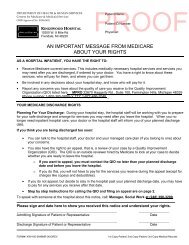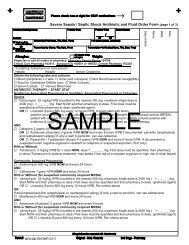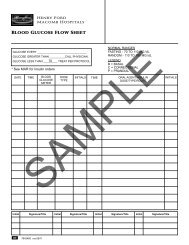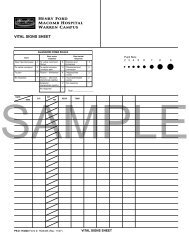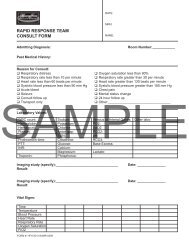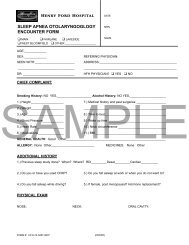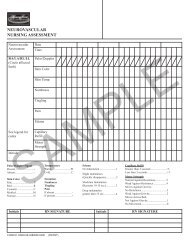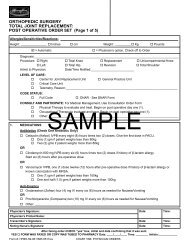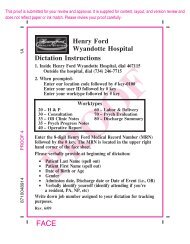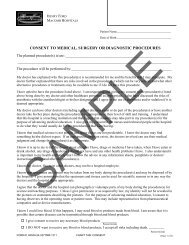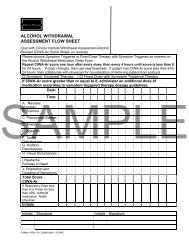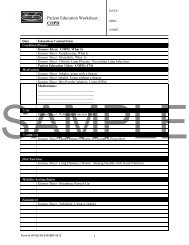LSC-26-0203-0605 Restor Consent Form.qxp
LSC-26-0203-0605 Restor Consent Form.qxp
LSC-26-0203-0605 Restor Consent Form.qxp
- No tags were found...
You also want an ePaper? Increase the reach of your titles
YUMPU automatically turns print PDFs into web optimized ePapers that Google loves.
SECTION 4:RESTOR® INDICATIONS, CONTRADICTIONS AND WARNINGSINDICATIONS:The RESTOR® procedure is indicated for the correction of presbyopia and other focusing errors such asmyopia and hyperopia. The candidate’s decision on whether to have the RESTOR® procedure must dependon his or her assessment of visual disability (e.g. impact on driving, reading, watching television and specialoccupational or vocational needs) and the perception of the impact of wearing glasses or contact lenses onlifestyle. Candidates must be aware that RESTOR® is an outpatient, elective procedure.WARNINGS:Candidates must make their surgeon aware of certain health problems including uncontrolled diabetes,autoimmune or collagen vascular disease, any medication or condition that renders the patientimmunocompromised. Candidates must make their surgeon aware of certain eye problems including amblyopia(lazy eye), strabismus (muscle imbalance), dry eyes, or any recurrent, residual or active eye condition,which may affect healing. Candidates must make their surgeon aware of unstable high blood pressure and/orangina. Candidates must make their surgeon aware of certain general health conditions including keloid scarringwith previous surgical healing, back problems, claustrophobia or other psychological problems, which mayaffect the surgery or recovery. Candidates must make their surgeon aware of medication allergies and anymedications they are taking to avoid potential drug interactions and allergic reactions.SECTION 5:PRE-PROCEDURE and POST-PROCEDURE CARE:Patient Initials: ______________Witness Initials: ______________PRE-PROCEDURE CARE:The screening examination performed by an surgeon is intended to assess a patient’s suitability for theRESTOR® procedure based upon a patient’s visual acuity and other factors, but not to identify or treat ocular(eye) disease. Ocular disease may be present prior to RESTOR® surgery or may develop after surgery, but itis unrelated to the surgical procedure. RESTOR® surgery will not treat other ocular diseases.You should have a complete eye examination with retinal evaluation prior to RESTOR® surgery and annuallythereafter to identify and treat ocular diseases. In general, patients with higher degrees of myopia have ahigher risk of retinal problems and reducing the degree of myopia with RESTOR® surgery does not lower therisk.SAMPLEIf you have had any heart problems in the past such as a heart attack, angina, heart failure or high blood pressure,it is recommended that you see your primary physician between 2 to 3 weeks prior to RESTOR® procedureto ensure your condition is compatible with the surgical procedure.Lung disease, such as asthma, emphysema, and chronic bronchitis are three respiratory ailments that cancomplicate RESTOR® surgery. Should you have one of these conditions, you should see your primary physician.Furthermore, patients with other diseases (diabetes, kidney, bowel disorder, etc) that require regular visitsand/or long term medications should see their primary physician prior to RESTOR® surgery to ensure yourcondition is compatible with the surgical procedure.Patient Initials: ______________Witness Initials: ______________FORM # <strong>LSC</strong>-<strong>26</strong>-<strong>0203</strong>-<strong>0605</strong>3
POST-PROCEDURE CARE:Post-operative follow-up care with an eye care professional is required. In most cases patients are seen againby their surgeon at post-op day one (+/- 1 day), post-op day 7 (+/- 3 days), post-op month one (+/- 7 days)and at post-op month 3, (+/- 7 days) to monitor healing. More visits may be required depending on your healingstatus. It is recommended yearly visits to your eye doctor for routine eye care.It is important to remember that right after RESTOR® surgery not to touch the eye in any way and not tosqueeze it tightly shut. If sutures were used in your eye, they often cause a gritty sensation as if somethingwas in the eye. This is expected and will gradually resolve as the sutures are absorbed.You will require various drops placed in your eye after RESTOR® surgery. Instructions for the use of variousdrops will be reviewed with you before surgery.Your operated eye will continue to require special care and attention. Instructions for care of your operatedeye will be reviewed with you before surgery. You also will be given general instructions on activities that willbe restricted during the post-operative period.If an additional procedure is needed or a complication occurs, a patient may be required to return to the surgerycenter or lengthen their stay at their expense. In some circumstances, a patient may have to travel for anadditional procedure at their expense. The final clinical results are dependant upon how your body heals inresponse to the RESTOR® procedure on your eye and upon properly following your post-operative careinstructions. Due to individual healing patterns, it is impossible to guarantee exact results in individual cases.Some patients either over or under respond to the RESTOR® surgical procedure and thus may have someresidual focusing errors as a final result.Patient Initials: ______________Witness Initials: ______________SECTION 6: PRESBYOPIA AND RESTOR®Presbyopia is the Greek word for “aging eyes”, and is the most prevalent eye condition in North America,affecting most people by the age of 40 and everyone by the age of 51. Presbyopia causes the natural lens ofthe eye to become less flexible. This lack of flexibility compromises the eye’s ability to switch from one focalpoint to another focal point. You will usually notice presbyopia when it becomes more difficult to read or seethings at close range. It is important to note that our eyes continue to change with age, and to understand thatthe presbyopia you have now will potentially worsen over time.SAMPLEAt this time, there is no cure for presbyopia. The typical solutions are all to some extent, a compromise of oneform or another. For many people, wearing reading glasses for near vision correction is troublesome enough,and wearing bifocals or progressive lenses is even less pleasant.The RESTOR® procedure is designed to permanently correct presbyopia by replacing the aging lens with asophisticated multi-focal lens implant that has the ability to focus light at both near and far. The intra-ocularlens is implanted in essentially the same location previously occupied by your natural lens. You will not be ableto feel the intra-ocular lens and it never has to be handled, adjusted or cleaned.RESTOR® is a procedure designed to functionally restore distance and near vision, but it may not completelyeliminate your need for reading glasses for fine print. In other words, the goal of RESTOR® is to reduce yourdependence on bifocals or reading glasses.Patient Initials: ______________Witness Initials: ______________FORM # <strong>LSC</strong>-<strong>26</strong>-<strong>0203</strong>-<strong>0605</strong>4
SECTION 7: RISKS AND COMPLICATIONSAs discussed earlier, all forms of vision correction surgery carry a certain degree of risk for adverse effects and complications.Problems can be related to the surgical component of the procedure or the healing component. Most surgicalproblems are associated with the healing process that takes place after the procedure and are usually resolved withinone to three months after the procedure. However, it is possible that some of these reactions or complications could belonger-term or permanent. Most complications improve or resolve within 6-12 months or with retreatment, but some surgicalor healing complications may result in permanent visual blurring, glare, discomfort or need for corrective contactlenses. In general, there is a small risk in the range of 1/1000 of experiencing a significant complication and a very smallrisk in the range of 1/3000 of a severe sight-threatening complication. Please read and initial this section carefully for abetter understanding and initial below.The risks of the RESTOR® PRESBYOPIA procedure revolve around 4 primary areas:1. Post-operative side effects, adverse effects and complications2. Refractive Complications3. Healing Complications4. Other Miscellaneous Complications1. Post-operative Side Effects, Adverse Effects and ComplicationsThere are several effects which may be encountered early in the post-operative period, which include foreign body sensation,pain or discomfort, sensitivity to bright lights, blurred vision, dryness of the eye, red or swollen eye, tearing andfluctuation in vision. Pain may be experienced during the first hours after surgery. It is very common to experience a foreignbody sensation during this time similar to an eyelash in your eye. Patients experiencing pain will be provided withmedication to take if necessary. Fortunately, pain is not always a sign of complication, but daily or more frequent examinationsmay be required if pain is persistent. Infection following RESTOR® surgery is rare but very serious and canpotentially even result in blindness. The most important long-term side effect is night glare, star bursting, haloes or simplyreduced visual quality under low light conditions. It is very common to have night glare early during the recoverycourse and night glare is more common when only one eye has been treated. In a small percentage of patients nightglare may be permanent and affect your night driving abilities.Patient Initials: ______________Witness Initials: ______________2. Refractive ComplicationsRefractive problems that may be encountered include too much correction, too little correction, a prescriptionimbalance between eyes, or aggravation of muscle imbalance problems. The RESTOR® surgical procedure may resultin over corrections and under corrections due to the variability in patient healing patterns and other surgical variables,leaving a patient nearsighted, farsighted or with astigmatism. This may or may not require patients to wear spectacles,contact lenses or undergo further surgery. Further surgery entails additional risk and is not guaranteed to provide an idealvisual outcome, although improvement is typically achieved. Patients may also heal differently between eyes, based upondifferences between eyes in pre-operative prescriptions, corneal curvature, variation in healing or other surgical variables.Differences in refraction between eyes is termed anisometropia; this is most severe when only one eye is treated, andmay result in a loss of depth perception, eye strain, headache, and double vision.SAMPLEPatient Initials: ______________Witness Initials: ______________3. Blurriness/Loss-of-Best Corrected Visual AcuityBlurriness is very common during the healing process. After the RESTOR® procedure, there is considerable improvementin vision within the first few days. It generally requires 3 to 5 days until vision is clear enough to drive; however itmay even take longer. Approximately 1-2% of patients independent of the-procedure performed will develop corneal irregularitiesreducing the sharpness, crispness and clarity of their vision preventing them from reading the bottom 2 or morelines on an eye chart that glasses, contacts or another surgery cannot restore. That is, initial blurriness resolves inapproximately 98%-99% of patients over 6 to 12 months, however it may be permanent in approximately 1-2% of treatedpatients. There is no way of predicting or predetermining that will be in this 1-2%. A patient, who loses sharpness, willhave vision that is worse than the vision before surgery. All forms of eye surgeries possess the same or higher risk/lossof best-corrected visual acuity,FORM # <strong>LSC</strong>-<strong>26</strong>-<strong>0203</strong>-<strong>0605</strong>5Patient Initials: ______________Witness Initials: ______________
4. Corneal Healing ComplicationsCorneal healing problems with RESTOR® are more likely to be experienced by patients corrected for higherdegrees of astigmatism. Corneal healing may not only affect the speed of visual recovery but the smoothness,and may produce visual blurring. Corneal scarring may be produced with RESTOR®. The most importantaspect of corneal healing following RESTOR® or any other form of vision enhancement surgery followingvision correction surgery is the development of corneal irregularities which may permanently affect the quality,crispness and sharpness of the final visual result. Corneal irregularities or irregular astigmatism is producedwhen the cornea heals in an irregular pattern. Irregular astigmatism from both healing and surgical complicationsmay result in a loss of best-corrected vision. Specifically, the best vision a patient measures aftersurgery even with lens correction may not be as good as the patient enjoyed before vision enhancement surgery.In some cases, patients will actually gain best-corrected vision.In certain cases, the vision may be severely impaired and affect the ability of a patient to drive legally, this ismost important in patients who already have reduced visual acuity from other causes. The RESTOR® procedureis not intended to increase the visual potential of a patient and many candidates with high prescriptionsoften are unable to read 20/20 before surgery and should not expect to read 20/20 after surgery. Furthermore,a patient who is best corrected before surgery to 20/40 is already borderline for legally driving and any loss ofbest-corrected vision from healing or surgical complications may prevent legal driving.Patient Initials: ______________Witness Initials: ______________5. Other ComplicationsOther possible complications that may be associated with the RESTOR® procedure include inflammation ofthe retina (macular edema), dislocated lens material, elevation of intra-ocular pressure (glaucoma), hemorrhage(choroidal hemorrhage) or corneal epithelial defect, secondary cataract (cloudiness of the lens), cornealscarring, corneal swelling, corneal ulceration or inflammation, irregularities of the cornea, endothelial cell loss(a loss of endothelial cell density, increase in irregularity of cell size or shape which may result in cornealswelling), inflammation of the iris, itching, double vision, drooping of the eyelid, contact lens intolerance andreading difficulty. The most common long-term side effect is dryness of the eyes. This may continue for severalmonths to a year after the procedure, and in a few cases, may be permanent. Patients may need to usemoisturizing eye drops during this period. There are cases where patients have significant dry eye symptomsfollowing surgery that require additional treatments or procedures beyond lubricant drops. In rare cases, thismay include the insertion of punctual plugs or similar therapies. These techniques have been used for yearsfor patients who have not had any surgical procedures but who have chronic dry eyes or dryness from contactlenses. It is important to note that it is impossible to list every conceivable complication that is not listedabove. Risks and complications that are considered to be unforeseeable, remote or not commonly known arenot discussed. In addition, there may be long-term effects not yet known or anticipated at the present time.The most severe possible complications would necessitate more invasive or repeated surgery and couldpotentially produce partial or complete loss of vision.SAMPLEPatient Initials: ______________Witness Initials: ______________SECTION 8: EXPECTATIONS OF THE PROCEDUREThe goal of the RESTOR® procedure is to achieve the best visual result the safest way. It is also important torecognize with the RESTOR® procedure, the goal is to allow patients to enjoy a full range of vision, withindependence from glasses for most activities. RESTOR® will not eliminate your need for reading glasses forfine print, but is useful for reading your watch, opening your mail or reading price tags without reading glasses.Complications are an inherent part of surgery and despite our best efforts, training and skill some patients willexperience problems. It is simply our hope to educate you as to what those problems may be so that you canmake an informed decision whether or not to proceed. No one ever believes that they will be in the small percentageof people that develops a significant complication, so it is important for all candidates to appreciatethat there are truly no guarantees.FORM # <strong>LSC</strong>-<strong>26</strong>-<strong>0203</strong>-<strong>0605</strong>6Patient Initials: ______________Witness Initials: ______________
SECTION 9:WRITTEN CONFIRMATIONPlease write in your handwriting the following two statements to confirm that you have understood andaccept that RESTOR® PRESBYOPIA procedure is an elective surgical procedure and as with all surgicalprocedures, the result cannot be guaranteed. That you acknowledge that although vision-threateningcomplications are quite rare, it is possible that partial or complete loss of vision may be produced asa result of a surgical or healing complication. That the procedure may not eliminate all of your PRES-BYOPIA, myopia, hyperopia or astigmatism and that additional correction with glasses, contact lensesor further surgery may be required.I understand that “there are risks and no guarantees”I understand that “I still need to wear glasses for distance vision or near vision or both”.SECTION 10: VOLUNTARY CONSENTPatient Initials: ______________Witness Initials: ______________Please sign below that you have carefully reviewed this informed consent document and that you havehad an opportunity to any questions that you may have answered. By signing below you also indicatethat you are aware that RESTOR® PRESBYOPIA procedure is an elective procedure, that you do notneed to have this procedure and that you understand your other surgical and non-surgical alternativesfor vision correction.SAMPLEPatient Full Name: (print):Patient Signature:Witness Full Name (print):Witness Signature:Surgeon Name (print):____________________________________________________________________________________________________________________________________________________________________________________________________________________________Surgeon Signature:Co-managing Doctor:Date of Procedure:_______________________________________________________________________________________________ - _______ - _______Month Day YearFORM # <strong>LSC</strong>-<strong>26</strong>-<strong>0203</strong>-<strong>0605</strong>7
Witness to Patient <strong>Consent</strong>I,________________________, hereby certify that I have discussed and explained the RESTOR®surgical procedure, the possible risks and benefits and alternative treatments, as outlined in the consentform, with______________________. The patient has confirmed to me that(s) he has received the explanationof those surgical procedures, possible risks and benefits and alternative treatments.Furthermore, the patient has confirmed to me his/her understanding of the information contained in theconsent form. I believe that the patient understands the explanations and answers, and freely andknowingly consents to the performance of the RESTOR® PRESBYOPIA procedure.____________________________Witness Signature_______ - _______ - _______Month Day YearSAMPLEFORM # <strong>LSC</strong>-<strong>26</strong>-<strong>0203</strong>-<strong>0605</strong>8



